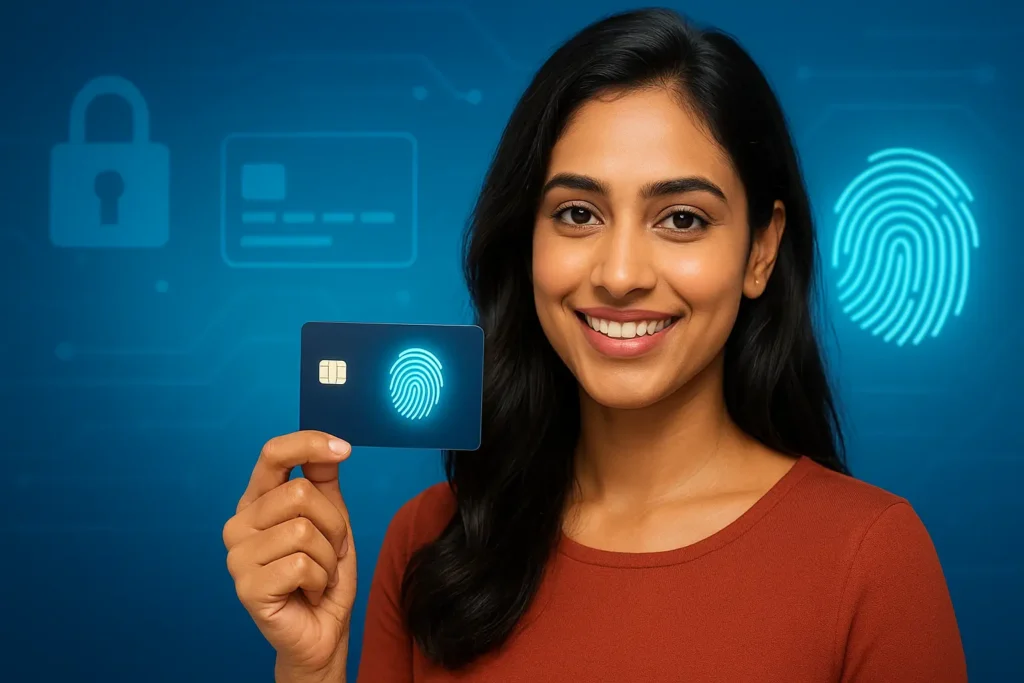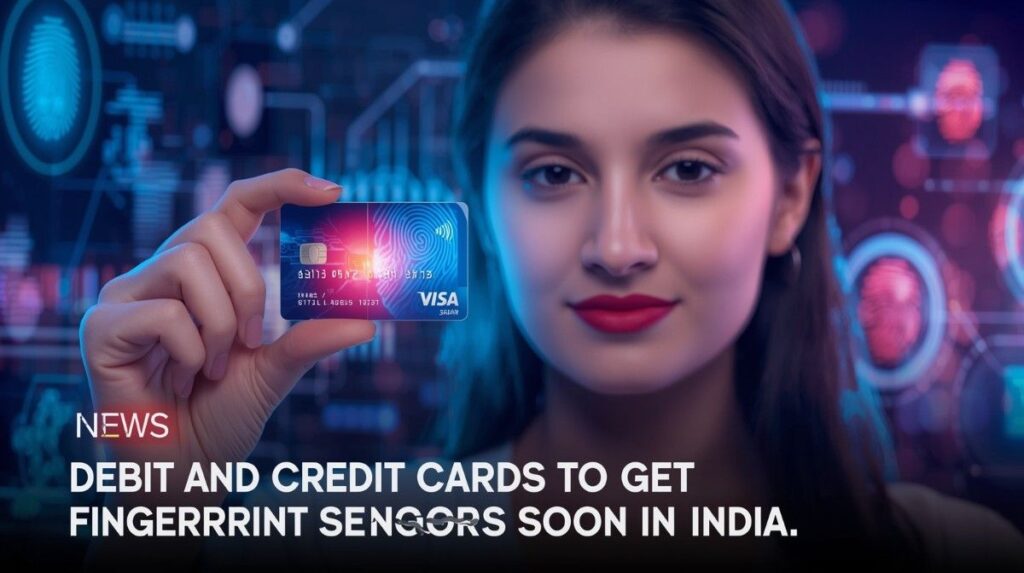A big change is on the horizon for debit and credit cards in India. Instead of entering a PIN (Personal Identification Number) to make payments, customers might soon be able to authenticate transactions using their fingerprint. This shift toward biometric cards aims to boost security and reduce fraud. In this article, we’ll explore how this works, when this could arrive, what benefits and challenges lie ahead, and how it fits into the wider world of digital payments.

Table of Contents
The Shift from PINs to Biometrics
At present, most debit and credit cards require a four- or six-digit PIN to confirm transactions at ATMs or point-of-sale (PoS) terminals. But PINs are vulnerable — they can be stolen, guessed, or observed by someone. To reduce such risks, industry players in India are now working to embed fingerprint sensors directly inside debit and credit cards.
These biometric cards will store the user’s fingerprint data securely. When you use the card in a shop or ATM, the sensor reads your fingerprint, verifies it, and only then the transaction is approved. No PIN needed (or as a fallback, a PIN might still remain for special cases).
The purpose is clear: make debit and credit cards safer, more convenient, and harder to misuse if lost or stolen.
Who’s Developing It & Where the Pilot Tests Are Happening
One of the key players in India is Seshaasai Technologies, a Mumbai-based card design and manufacturing company. They supply cards to various banks and financial institutions, and they are reportedly developing the biometric system that could be built into debit and credit cards. This advanced stage of development suggests the solution may not be far from rollout.
Fingerprint sensors on cards are also being tested internationally. Visa, for example, is conducting pilot programs in parts of Europe, North America, and Asia to see how well the technology functions in real-world settings before large-scale deployment.
Another company, IDEX Biometrics, has announced bringing biometric payment cards to the Indian market. Their technology would allow the biometric data to remain on the card, making it more private and secure. This aligns with global trends where new cards embed biometric sensors without requiring changes to existing payment infrastructure.
How the Biometric Debit & Credit Card Will Work
Here’s a simple breakdown:
- Enrollment
You’ll register your fingerprint with the card issuer (a bank or card company). This may happen at a branch or via a secure process at home using a device that connects to the card. The fingerprint data is converted into an encrypted template and embedded into the card’s secure chip. - Storage
Your fingerprint template is stored on the card itself, not on a remote server (in many designs). That means every time the card is used, verification happens locally. This helps protect your biometric data from large-scale data breaches. - Transaction / Verification
When you insert or tap the card at a terminal, the sensor reads your fingerprint. If it matches the stored template, the transaction is authorized. If it doesn’t, or if the sensor can’t read your fingerprint (due to dirt, injury, etc.), you may either retry or fall back on entering your PIN. - Support for Online / E-commerce Use
For online card payments, biometric authentication may also come into play. In one such development, Federal Bank (India) in collaboration with fintech firms has introduced biometric authentication for e-commerce transactions, so instead of OTPs, users can verify payments via fingerprint or Face ID. This indicates a convergence where debit and credit cards will use biometrics both offline (physical) and online.

Benefits of Biometric Debit and Credit Cards
This shift to fingerprint-enabled cards brings a number of benefits:
- Enhanced Security: Because your fingerprint is unique, replication or theft is extremely difficult compared to stealing a PIN.
- Zero/Lower Fraud Risk: Even if someone steals the card, they can’t use it without your fingerprint.
- Better User Experience: You won’t need to remember PINs or type them in constantly.
- Faster Transactions: Authorization via fingerprint is rapid — possibly only taking a few seconds.
- Support for Online Payments: Instead of OTPs (which can be intercepted or phished), biometric authentication could simplify and secure online use of debit and credit cards.
- Possibility of Dynamic Security Measures: Some cards may also adopt changing CVV codes (a code that changes dynamically) or blockchain-based identity verification to further strengthen security.
Real-World Steps Already Taken
Some important moves are already underway:
- Federal Bank has launched biometric authentication for e-commerce, replacing OTPs in some cases with fingerprint or Face ID verification.
- Mastercard launched a “Payment Passkey” service, letting users confirm payments with device biometric features like fingerprint or face scan, reducing dependence on passwords or OTPs.
- IDEX Biometrics announced entry into the Indian market with plans to bring biometric payment cards.
- Globally, Mastercard is rolling out biometric-enabled cards built on the IDEX Pay platform, integrating fingerprint sensors into credit cards. Wikipedia
These developments show that biometric features on debit and credit cards are not just theory — they are becoming tangible.
Challenges & Risks to Address
While the prospect is exciting, rolling out biometric debit and credit cards is complex, and several challenges must be tackled:
- Privacy & Data Safety
Storing biometric data even on a card (rather than a central server) requires careful encryption and security protocols. Users may worry: what if someone steals my fingerprint data? Clear rules and robust safeguards will be essential. - False Rejection / Error Rate
Fingerprint sensors can fail to read in certain conditions (wet fingers, scars, dirt). If verification fails repeatedly, users might revert to PINs — which reduces the benefit. - Cost of Implementation
Upgrading or manufacturing biometric cards is more expensive. Card issuers, banks, and manufacturers will need to invest money, infrastructure, and training. - Backward Compatibility
Many old ATMs or PoS terminals may not support biometric capabilities. Ensuring that newly issued debit and credit cards still work with existing systems is important. - Regulatory & Compliance Issues
The Reserve Bank of India (RBI) has guidelines for two-factor authentication. Any biometric solution must align with these rules. Moreover, data protection laws in India are evolving; there must be legal clarity on biometric data. - Adoption & Acceptance
Users need to accept biometric methods. Some may resist giving their fingerprint. Education, transparency, and trust-building will help. - Fallback Mechanisms
There must always be fallback—if the sensor fails or a person can’t use a fingerprint (e.g. some physical disabilities). A PIN backup or alternative authentication must remain.
A Timeline: When Could It Arrive?
Although no specific nationwide date has been announced, the developments suggest the rollout could happen in phases:
- Pilot / Testing Phase: Already happening within India and abroad, involving banks, card manufacturers, and payment networks.
- Limited Launch: Selected cities or customer segments might receive biometric debit and credit cards first.
- Full-Scale Rollout: Over time, as infrastructure catches up and costs reduce, the cards may become standard.
Because Seshaasai Technologies is reportedly in advanced stages of development and global pilots are ongoing, some estimates suggest that we might begin to see biometric debit and credit cards in India within the next one to two years — assuming no major roadblocks delay them.
How Biometric Cards Fit Into India’s Payment Landscape
To appreciate how big this shift is, we should see it in context:
- India has rapidly adopted digital payments: UPI (Unified Payments Interface) powers instant bank-to-bank transfers and peer-to-merchant payments. Wikipedia
- Debit and credit cards remain critical, especially for offline shopping, travel, large purchases, and compatibility with global systems.
- The integration of biometrics in cards can unify security standards across payments — whether using UPI, card, or digital wallets.
By combining the strengths of cards (versatility, wide acceptance) with the security of biometrics, the future could be smoother, safer payment experiences.
What Users Should Know & Do
If you hold or plan to get debit and credit cards in India, here are a few tips and things to expect:
- Be ready to enroll your fingerprint when banks start issuing biometric cards.
- Don’t discard PINs yet — at least initially they’ll act as a fallback.
- Ask questions about privacy — banks and issuers should explain how your biometric data will be used and protected.
- Check compatibility — make sure your cards still function at older ATMs or PoS machines.
- Be patient during transition — early versions may have hiccups or delays.
- Stay informed on regulatory changes — as biometrics become mainstream, India’s laws on data protection may strengthen.
Why This Move Matters
Embedding fingerprint sensors in debit and credit cards is more than a tech novelty. It addresses real pain points:
- Fraud on card transactions has been a serious issue worldwide, including in India.
- OTP (one-time passwords) used in online card payments are vulnerable to phishing, SMS interception, or SIM swaps.
- Eliminating or reducing reliance on PINs and OTPs can enhance convenience without compromising security.
- If successful, biometric cards may reduce banking costs tied to fraud, card reissuance, and support.
So, this is not just about upgrading cards — it’s about rethinking how trust works in payments.
Final Thoughts
The era of entering PINs for every transaction may soon be behind us — thanks to the introduction of biometric debit and credit cards in India. These cards, equipped with fingerprint sensors, promise improved security, better user experience, and stronger defense against fraud.
However, for this transformation to succeed, key challenges around privacy, cost, infrastructure, and acceptance must be navigated carefully. If banks, regulators, and technology providers work closely and transparently, we may see this shift in the next couple of years.
When that happens, using your debit and credit cards could become as simple—and safe—as placing a finger.

